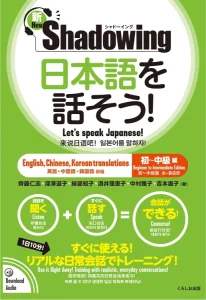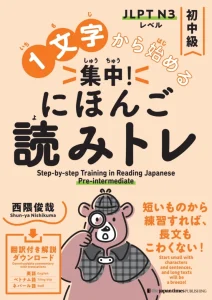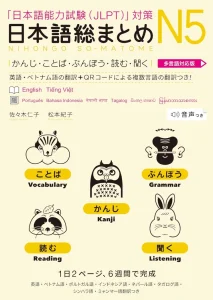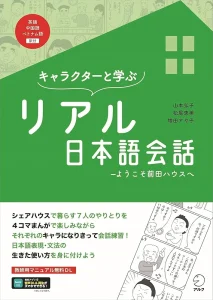Learn with Character – Real Japanese Conversation (キャラクターと学ぶ リアル日本語会話) helps learners to use lively, natural Japanese that fits the situation-and lets their own personality shine through.
Even if you’ve mastered the “correct Japanese” from textbooks, it’s common to feel unsure in real-life conversations. You might wonder: Am I really understanding what the other person means? Am I expressing myself clearly? Does my Japanese sound natural? This book is here to help. By following the realistic interactions of seven characters, you’ll learn how to read between the lines, express your feelings in your own style, get your message across smoothly, and present yourself appropriately in different situations.

What does Learn with Character – Real Japanese Conversation cover?
This book is a practical Japanese conversation textbook designed for learners who want to go beyond textbook Japanese and master the kind of "real" Japanese used in everyday interactions. It uses a story-driven, comic (4-panel manga) format to make learning engaging and authentic.
Main Features & Structure
- Story-Based Learning: The book follows seven unique characters living together in a share house. The residents differ in nationality and personality, and the story begins when a Vietnamese character named Nguyen moves in.
- Three-Part Story Arc: The narrative is divided into three parts: "Meeting," "Conflict," and "Understanding," reflecting typical stages of human relationships and communication in daily life.
- 4-Panel Manga Format: Each lesson is presented as a two-page spread: the left page features a 4-panel comic strip, and the right page provides exercises that focus on understanding the intentions and emotions behind the conversations.
Student Review

‘Learn with Character – Real Japanese Conversation’ is an excellent intermediate resource for learners who want to move beyond the confines of strict grammar-focused study and start engaging with more authentic Japanese. The book centers on helping readers infer character motivations, recognize different speech styles, and check their understanding in a natural context.
Each lesson features a concise, eight-panel manga strip, typically depicting conversations between two or three characters as they express their opinions or motivations. After reading, you’re prompted with questions that encourage you to share your own thoughts on the dialogue or identify the most appropriate responses for the situations presented.
What sets Real Japanese Conversation apart is its focus on developing your ability to interpret meaning from context-something that beginner textbooks, with their formulaic Q&A structure, rarely offer. Here, you’re encouraged to draw on your existing knowledge and think creatively about how to respond, rather than simply following set language patterns. This makes it a great stepping stone for anyone ready to experience Japanese as it’s actually spoken, and to start building real conversational skills.
It’s definitely best to use this book alongside a teacher, ideally a native Japanese tutor. Since the main goal is to help learners pick up on nuance, having a teacher makes a big difference-they can clarify whether you’ve truly understood the meaning behind the manga panels and guide you toward more natural responses.
Without a teacher, it can be tricky to know if your interpretations are accurate, since the book doesn’t provide explicit explanations in English. Plus, both the questions and manga panels are written entirely in Japanese, so having someone to support you through the trickier parts can really help you get the most out of the material.
‘Learn with Character – Real Japanese Conversation’ stands out for the way it presents scenarios that students are likely to encounter in everyday life in Japan. Each scenario is structured around a familiar narrative arc-‘encounter,’ ‘conflict,’ and ‘understanding’-which mirrors the natural flow of real conversations and interactions. This approach not only makes the material more engaging but also helps learners practice responding to situations they might genuinely face, such as shopping, taking out the rubbish, or navigating cultural differences.
The book is set in a share house, featuring two Japanese characters and five housemates from various nationalities. Over the course of the book, students get to know each character’s personality, and are encouraged to anticipate how different characters might react in various situations. This ongoing familiarity builds a sense of immersion and helps learners think more deeply about interpersonal dynamics and communication styles.
For anyone living in Japan, studying there, or planning a move, this structure is particularly valuable. The scenarios reflect daily life and common challenges, making the practice directly relevant and practical. By focusing on realistic situations and character-driven stories, the textbook offers a bridge between classroom Japanese and the nuanced, spontaneous conversations you’ll encounter in the real world.
The book starts off fairly simple, but works by checking the student’s understanding of grammar point or particles in context. An early lesson focuses on the particle ね for example, but tests the student’s understanding based on a real conversation. This can be invaluable in teaching students where it is often appropriate to use these to adjust the tone of their speech.
Teacher Review

Before using Learn with Character – Real Japanese Conversation:
Before using this book you need to have finished both Genki 1 and Genki 2 or Minna no Nihongo 1 & 2.
While the conversations are fairly simple to begin with, it still requires the learner to have a strong grasp of particles and how they influence tone in speech.
What to read next?
A great next step after finishing this book is to pick up Yomu kara Hajimeru Nihongo Kaiwa Workbook. This workbook really takes things up a notch-it gets you reading longer passages and encourages you to craft more thoughtful, extended responses. Instead of just sticking to everyday small talk, you’ll dive into deeper topics and get plenty of practice expressing your own opinions and experiences in Japanese.

Shadowing: Let’s Speak Japanese! Beginner to Intermediate
Review of “New Shadowing: Let’s Speak Japanese!” N5–N2, audio shadowing drills and casual–polite dialogues to boost natural speech.

Step-By-Step Training in Reading Japanese: Pre-Intermediate
Master JLPT N3 reading with clear, progressive training books that improve kanji, grammar, and comprehension skills.

Nihongo Sou Matome N5
Structure your study with Nihongo Sou Matome JLPT N5! Prepare for your exam with 6 weeks of planned grammar, listening, vocab and kanji study.

